| Mono Centric |
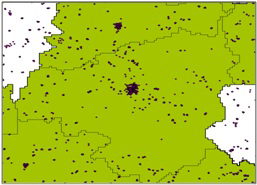 |
Catchments with a mono centric morphological profile have only one distinct concentrated settlement in the catchment
- Cluster middle, higher and some lower order facilities at the node.
- Provide lower order facilities at outlying settlements if these can be supported and
if these are necessary or desirable.
- Only use mobile services to service outlying areas if essential.
|
| Bi-Centric |
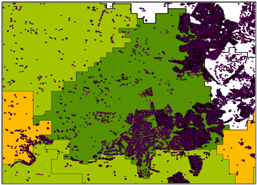 |
Catchments with a bi centric morphological profile have two distinct concentrated settlements
in the catchment
- Cluster higher order facilities at the most prominent node.
- Split middle order facilities among the two settlements and cluster them.
- Only use mobile services to service outlying areas if essential.
|
| Poly Centric |
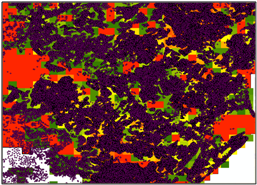 |
Catchments with a poly centric morphological profile have more than two distinct settlements
in the catchment. This type of profile is mostly found in City Regions and Cities.
- Provide facilities where needed.
- Cluster facilities at central accessible places on transport routes or at nodes.
|
| Scattered Dense |
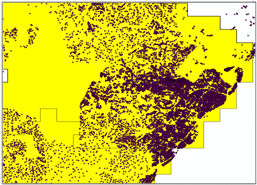 |
Catchments with a scattered dense morphological profile have a continuous dense point settlement
coverage structure. These catchments are not as dense as metroplitan areas but are also not
sparsely populated – in many instances having more than 100 people per km2.
- Locate most of the middle and higher level facilities within the main node.
- If the population can support several facilities of same type, locate towards periphery.
- Ensure minimum density and distance threshold criteria are met.
- Mobile and periodic services to be considered as a final option.
|
| Scattered Clusters |
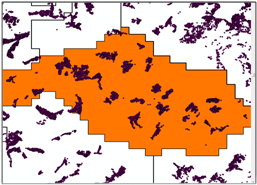 |
Catchments with a scattered clusters morphological profile have clusters of non-uniform and non-continuous
dense settlements across the catchment.
- Calculate facility requirements for entire catchment.
- Locate higher and middle order facilities at the main node and distribute lower order
facilities at selected clusters where requirements are met.
- Distribute lower order facilities among clusters and adjust sizes appropriately.
- Large clusters and those furthest from the central node should be given preference.
- Mobile and periodic services to be considered as a final option.
|
| Scattered Sparse |
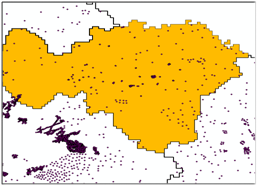 |
Catchments with a scattered sparse morphological profile have sparsely scattered settlement points
irregularly distributed across the catchment.
- Middle order facilities possibly not required if within 25km of a level 6 catchment or
higher or a priority node.
- If remote, facilities may be supported at main node, at population concentrations or
on main roads if the catchment population can support such facilities. Identify closest
priority node and ensure it has all major middle order services.
- Each cluster to be checked in terms of the viability of certain facilities.
- Mobile and periodic services to be considered as a final option. This is a typical situation
where boarding facilities for schools may be appropriate.
|
| Dense |
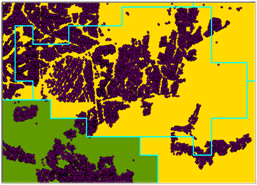 |
Catchments with a dense morphological profile are largely composed of continuously dense settlement
with no distinguishable settlement points
- Place all middle to high order facilities in the catchment’s identified town or settlement
point.
- Some low order facilities can be placed at peripheral settlements.
- Some middle and higher order facilities may be placed outside of the identified town
or settlement point if and where requirements are met, i.e. if more than 25km from
node.
- Mobile and periodic services to be considered as a final option.
|
| Dense Linear |
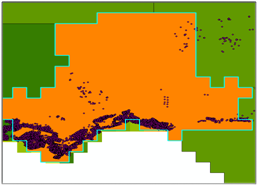 |
Catchments with a dense linear morphological profile have a linear pattern of densely populated
settlement; this may mean it has developed alongside a river, road or the coast.
- Middle and higher order facilities must be located at the catchment’s identified town
or settlement point on a main route.
- Identify sub-nodes and clusters where middle order facilities can be supported if areas
are out of reach.
- Check that facilities meet the minimum threshold and distance requirements – if not,
distance criteria can be stretched up to 1.5 of maximum distance (especially if public
transport is available).
- Mobile and periodic services to be considered as a final option.
|
| Sparse Linear |
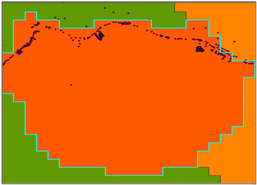 |
Catchments with a sparse linear morphological profile have a linear pattern of sparsely populated
settlement; this may mean it has developed alongside a river, the coast or a road.
- No permanent higher order services.
- Mobile services are advisable.
- Middle and lower order facilities should be located at the catchment’s identified town
or settlement point or distributed evenly along the main access road if there is
sufficient demand.
- Mobile and periodic services to be considered as a final option.
- This is a typical situation where boarding facilities for schools may be appropriate.
|








